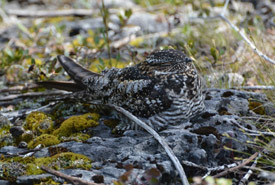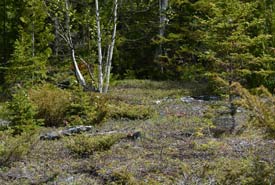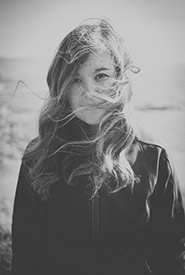A whoosh in the night

Common nighthawk resting on its nest (Photo by NCC)
Wandering through the forests, grasslands, and alvars of the Bruce Peninsula at dusk brings a certain calm to the soul; a type of peace that is seldom found in the bustle of a city at night. The forests are abuzz with the sounds of nocturnal creatures that live here.
The soft whistles of the northern saw-whet owl linger in the warm air, interrupted occasionally by the American woodcock’s nasal call, emanating from low on the dark forest floor. Perhaps one of the most startling sounds heard in forest clearings and the open alvars (natural clearings of exposed limestone bedrock) on the Bruce is the whooshing “Hooov” of a male common nighthawk performing a dive.
Despite their misleading name, common nighthawks are not hawks at all, but rather members of the nightjar family. The nightjar family was bestowed with the latin name Caprimulgidae, which translates to “goatsucker,” based on the false belief that they sucked milk from sleeping goats. Farmers as recent as a few centuries ago believed that these aerial insectivores (species that feed almost exclusively on insects in flight) flying around pastures were waiting idly by to milk an unsuspecting goat!
In the fading light of the day or early morning you may be lucky to see the long-winged nighthawk flying quickly by as it performs a breathtaking flight display through the air. These “dives” are initiated when a male circles just above the tree line, and abruptly begins a head-first fall to the ground with its wings closed tightly against its body. The fall continues until the nighthawk is only a few metres from the ground before it pulls up by flexing its wings in a downward direction.
The buzz, or whooshing, “Hooov” heard at the end of the display is created by the air rushing across the nighthawk’s wingtips. The deeper the dive, the steeper these amazing birds need to fly upwards to regain control, and the louder and more impressive their flight display becomes.
Male common nighthawks may dive to impress a nearby female, or to ward off territory intruders. If a male is attempting to court a female, he will land next to the female following the spectacle, spread his wings and shake his tail from side to side, showing off his white throat patch, all while making a croaking noise. If you are ever so lucky to witness this display, be sure not to be wooed yourself!
Not only are common nighthawks impressive aerial acrobats, they have also mastered the art of camouflage, or background matching. The grey, white, brown and black plumage (feathers) of a common nighthawk allows them to blend in with the ground of forest floors or alvars, where they like to nest, as well as on tree branches and logs, where they rest.
Common nighthawks are so well camouflaged that experienced birders often fail to locate them when they are within a few metres! Test your identification skills and try to find the common nighthawk in the picture below.
I have been lucky to have had several encounters with common nighthawks, including one on the Nature Conservancy of Canada’s Shining Rainbow Deer property located on the Northern Bruce Peninsula. On a warm summer day in 2015, my supervisor Laura and I were doing a site visit during which we were mapping species at risk, inventorying plants and bird species and doing a general walk through the property.
Suddenly, after an exciting encounter with a Massasauga rattlesnake, I noticed something on the ground that looked like it didn’t belong. With a quick gasp, I clutched Laura’s arm and tried to contain my excitement as I whispered that we were only feet away from nesting common nighthawk. After a few quick photos, and a lot of quiet exclamations, Laura and I crept away from the nesting bird to avoid disturbing it.
If you are wondering why this common nighthawk looks like it is just resting on the ground rather than on a nest, it is because common nighthawks do not build nests at all (except by occasionally dragging a few sticks over to keep up appearances). Rather, they rely on their camouflaged eggs to remain unseen!
So the next time you are walking through the forest at dawn or dusk, listen for the whooshing buzz of a common nighthawk, and rest assured that your goats are safe from this remarkable camouflaged aerial daredevil!



